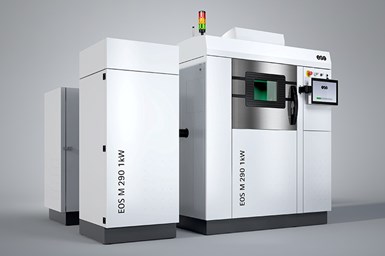EOS Metal AM System Engineered for Demanding Materials
The EOS M 290 1kW metal printer features a one-kilowatt laser with the flexible, midsize frame to deliver the power needed to maximize production of industrial applications for copper and copper alloy, with more materials coming.
Share






EOS M 290 1kW metal printer. Source: EOS
EOS’ M 290 1kW metal printer, part of the EOS M 290 family, is specifically designed for copper and copper alloy 3D printed applications. This laser powder bed fusion (LPBF) metal additive manufacturing (AM) platform was designed with serial production in mind, as a variant of its robust industry standard, but equipped with a 1 kW laser to handle challenging copper applications.
The EOS M 290 1kW was developed by EOS’ AMCM group to support the design and manufacturing of copper inductor applications and is well suited for a wide range of industries, including space, energy and mobility/transportation. These industries typically leverage copper and copper alloys, where the challenge of 3D printing copper applications (like heat exchangers and inductors) is overcome with the powerful laser and other technologies and materials working in tandem. At launch, EOS Copper CuCp and EOS Copper CuCrZr materials are fully qualified on the system, and additional materials will be added to the machine compatibility portfolio later in 2024.
The high beam quality of the 1kW laser spot and the detailed resolution are well suited for producing highly complex components that require high intensity. With the 1,000 watts made available through this system, it is specialized for processing copper applications.
The EOS 290 1kW features a build volume of 250 × 250 × 325 mm (9.85 × 9.85 × 12.8"). It has a powerful 1,000-W laser with a production volume rate of up to 55.4 (cm³/hr.), a scanning speed up to 7.0 m/sec. (23 ft./sec.) and a focus diameter of approximately 90 µm.
Related Content
-
The Benefits of Vertically Integrating Metal 3D Printing and Machining
Having 3D printing and machining within one organization enables Addman’s engineers to collaborate and consolidate so it can quickly make successful metal 3D printed parts.
-
Additive/Subtractive Hybrid CNC Machine Tools Continue to Make Gains (Includes Video)
The hybrid machine tool is an idea that continues to advance. Two important developments of recent years expand the possibilities for this platform.
-
Designing a 3D Printed Part with Machining in Mind
Designing extra stock and mounting features into a 3D printed part can aid in machining processes downstream.

















.jpg;maxWidth=300;quality=90)



